Stages of Bedsores

Bedsores, Pressure Sores or Pressure Ulcer - These happen when you put too much pressure on one area of your body for an extended period of time. This cuts off blood flow to the area and causes soreness. You're at risk of developing bedsores if you spend long periods in bed or sitting down, such as during bed rest or while using a wheelchair.
Your doctor may refer to the “stage” of your pressure sores. The stages are classified according to how deep the sores penetrate, which will determine their required treatment. If caught early, these types of sores usually heal within a week with minimal discomfort or pain. However, if left untreated they can worsen quickly. You'll know the sore is healing when it begins to shrink and new pink tissue appears around the wound site.
Stage 1
This is the mildest stage. These pressure sores only affect the uppermost layer of your skin.
Symptoms: Pain, burning, or itching are common symptoms. The spot may also feel different from the surrounding skin: firmer or softer, warmer or cooler.
If you spot a red area on your skin, pay close attention to it. If you have darker skin, the discoloration may not be as noticeable. The spot shouldn't lighten when you press on it for 10-30 seconds or even minutes after taking the pressure off. This means that there's less blood getting to the area.
What to do: The top priority when you have a pressure sore is to relieve the pressure. To do so, change your position or use foam pads, pillows, or mattresses. If you spend long periods of time in bed, try to move at least once every 2 hours. When sitting down, move every 15 minutes instead. You may require assistance from someone else. Gently wash the sore with mild soap and dry it afterwards. Consuming foods that are high in protein, vitamins A and C, and minerals such as iron and zinc will improve your skin health. Also, drink lots of fluids.
Recovery time: A Stage 1 pressure sore may go away in as little as 2 or 3 days.
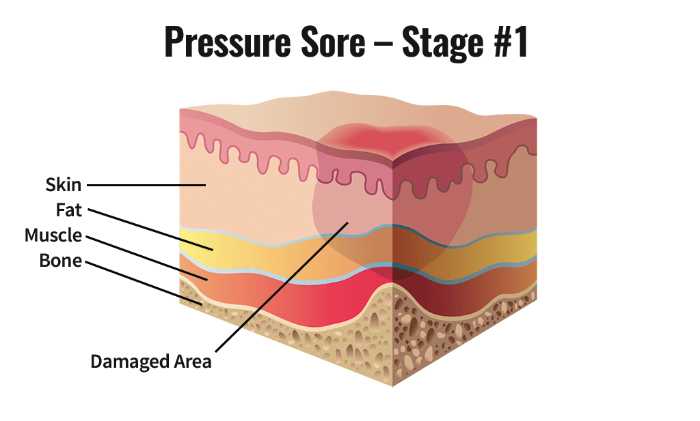
Stage 2
This happens when the sore digs deeper below the surface of your skin.
Symptoms: Skin is broken, leaving an open wound, or looks like a pus-filled blister. The area is swollen, warm, and/or red. The sore may ooze clear fluid or pus. And it’s painful.
What to do: Repeat the steps from Stage 1. In addition, clean the wound with water or a salt-water solution and dry it gently. This process may cause pain, so ask your doctor if you should take a pain reliever 30 to 60 minutes before starting. Keep the sore covered with a see-through dressing or moist gauze. If you notice signs of an infection (such as pus, fever, or redness), tell your doctor immediately.
Recovery time: A Stage 2 pressure sore should get better in 3 days to 3 weeks.
Stage 3
These sores have reached the second layer of skin and are now affecting fat tissue.
Symptoms: This sore is different than others because it
– looks like a crater,
- may have a bad odor, and
- may show signs of infection (red edges, pus, odor, heat, and/or drainage).
What to do: If your sores reach stage 3, you will need to take more care of them. Talk to your doctor about removing any dead tissue and prescribing antibiotics to fight infection. If you weren't using a specialized bed or a ripple mattress yet, this is the time to get these medical equipment.
Recovery time: A Stage 3 pressure sore will take at least one month, and up to 4 months, to heal.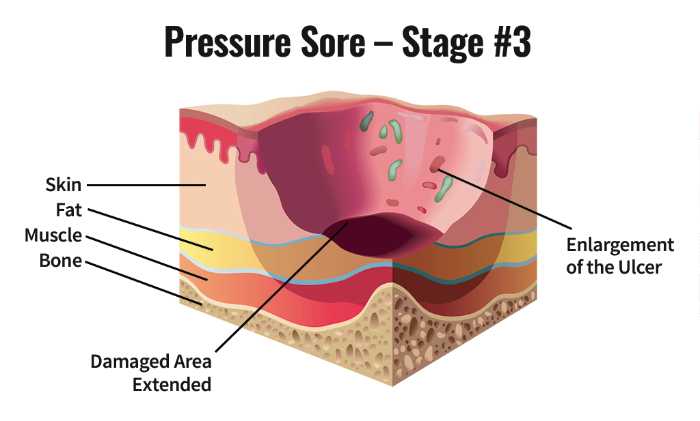
Stage 4
These sores are the most serious. Some may even affect your muscles and ligaments.
Symptoms: The sore is deep and big. Skin has turned black and shows signs of infection -- red edges, pus, odor, heat, and/or drainage. You may be able to see tendons, muscles, and bones.
What to do: Tell your doctor right away. These wounds need immediate attention, and you may need surgery.
Recovery time: A Stage 4 pressure sore could take anywhere from 3 months or much longer, even years, to heal.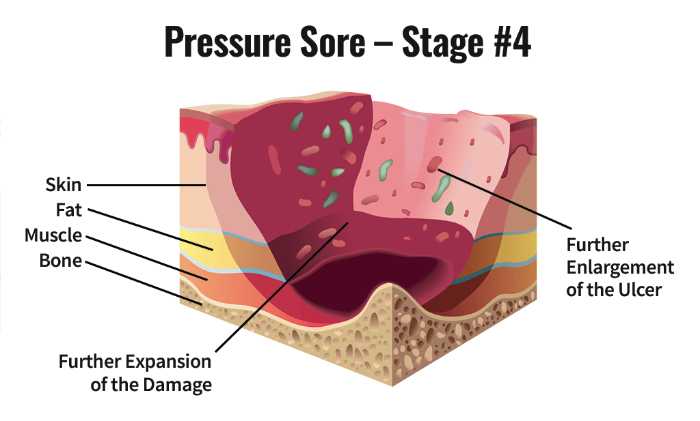
Other Stages
In addition to the 4 main stages for bed sores, there are 2 others:
Unstageable - Sometimes, it’s not possible to measure the depth of a sore or the amount of tissue damage that has occurred. This makes it difficult to fully evaluate and stage an ulcer.
This may be due to the presence of a hard plaque called an eschar inside the sore. The sore may look tan, brown or black. Ulcers can also contain discolored debris known as slough that may appear yellow, tan, green or brown. Your doctor may need to remove the eschar or slough to determine the full extent of the ulcer.
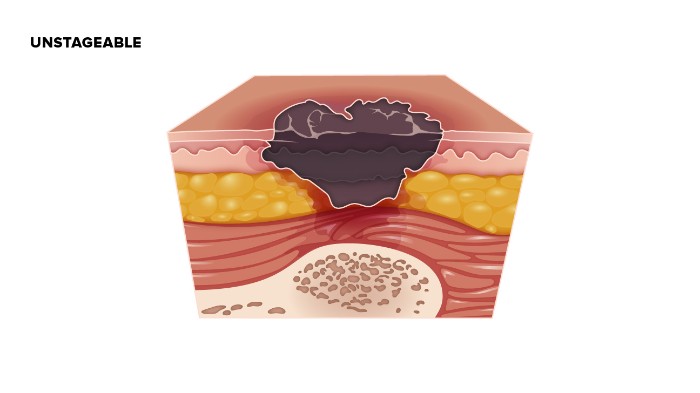
Further imaging or surgical evaluation of the area may be required.
"Suspected Deep Tissue Injury" (SDTI). This is when the surface of the skin looks like a Stage 1 or 2 sore, but underneath the surface, it’s a Stage 3 or 4.
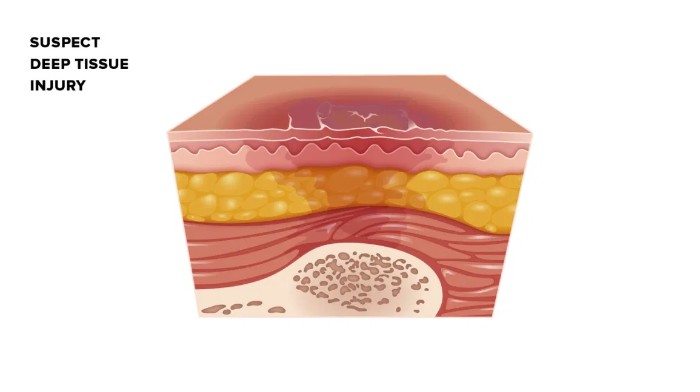 Complications of bedsores
Complications of bedsores
In order to heal the developed bedsores, it takes days, months, or even years. It may cause life-threatening if the bedsores are not to be treated well, such as bone and joint infections, cancer, sepsis, or cellulitis.
How to do a wound dressing on bedsores?
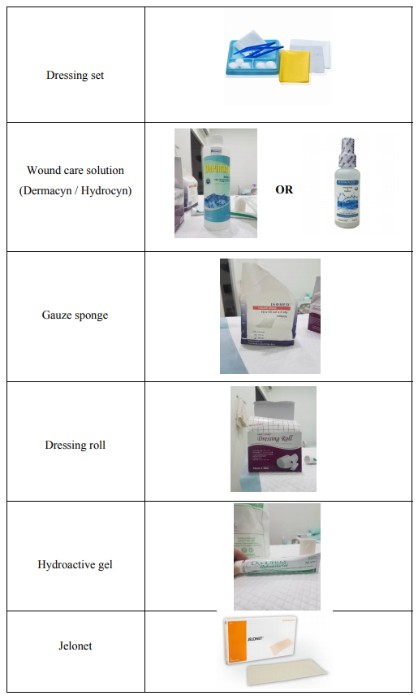
Steps of wound dressing on bedsores (recommended):

Where to buy high quality medical equipment and supplies?
Visit our online store at www.neolee.com.my
Customer enquiries:
Phone: (KL) 03-92129402 / (JB) 07-5190350
Email: general.enquiry@neolee.com.my
or Visit our showroom
For more stories like this, join our Facebook community on Facebook
Need help with your order? chat with us here via Whatsapp
Nov 08,2022
